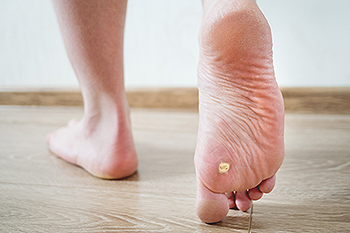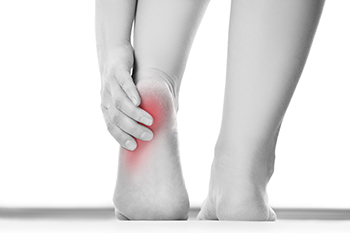Items filtered by date: May 2023
Get Professional Care for a Broken Foot or Ankle
Painful Plantar Warts

People who are afflicted with plantar warts may have difficulty walking. These growths are found on the soles of the feet and can cause severe pain and discomfort. This is a result of the consistent weight the feet endure while walking and standing during the day. Plantar warts are caused by a virus that is known as the human papillomavirus, or HPV. This virus is contagious, and lives in warm and moist environments. These can consist of public swimming pools, locker rooms, and shower room floors. It is beneficial to wear appropriate shoes while in these areas, such as flip flops or water shoes. This type of wart will generally take several weeks or months to completely disappear. Many patients seek treatment to relieve the pain, which may include removal for faster relief. If you have a plantar wart, it is suggested that you speak to a podiatrist who can guide you toward the treatment that is correct for you.
Plantar warts can be very uncomfortable. If you need your feet checked, contact Edward Sharrer, DPM from Crestwood Podiatry and Wound Care Clinic. Our podiatrist will assist you with all of your foot and ankle needs.
About Plantar Warts
Plantar warts are the result of HPV, or human papillomavirus, getting into open wounds on the feet. They are mostly found on the heels or balls of the feet.
While plantar warts are generally harmless, those experiencing excessive pain or those suffering from diabetes or a compromised immune system require immediate medical care. Plantar warts are easily diagnosed, usually through scraping off a bit of rough skin or by getting a biopsy.
Symptoms
- Lesions on the bottom of your feet, usually rough and grainy
- Hard or thick callused spots
- Wart seeds, which are small clotted blood vessels that look like little black spots
- Pain, discomfort, or tenderness of your feet when walking or standing
Treatment
- Freezing
- Electric tool removal
- Laser Treatment
- Topical Creams (prescription only)
- Over-the-counter medications
To help prevent developing plantar warts, avoid walking barefoot over abrasive surfaces that can cause cuts or wounds for HPV to get into. Avoiding direct contact with other warts, as well as not picking or rubbing existing warts, can help prevent the further spread of plantar warts. However, if you think you have developed plantar warts, speak to your podiatrist. He or she can diagnose the warts on your feet and recommend the appropriate treatment options.
If you have any questions please feel free to contact our office located in North Little Rock, AZ . We offer the newest diagnostic and treatment technologies for all your foot and ankle needs.
Dead Skin on the Feet

Skin is one of the most important organs in the human body. Taking care of the skin covering the feet can be an essential element of maintaining proper foot health. Patients often wonder why dead skin can build up on the feet. There are many different potential explanations for dead skin build-up. For example, when the feet are subject to persistent pounding and friction, this can ultimately lead to dead skin cell build up. Importantly, when the feet are dehydrated and unmoisturized, this can exacerbate dead skin accumulation. When dead skin cells build up over time, it can be important to gently remove that dead skin. An individual might go about doing this in consultation with their podiatrist through exfoliation with a pumice stone. A patient might even use an electric callus remover. If you are someone that struggles with dead skin cell build up on the feet, it is suggested that you contact a podiatrist today for more information.
If you have any concerns about your feet, contact Edward Sharrer, DPM from Crestwood Podiatry and Wound Care Clinic. Our podiatrist can provide the care you need to keep you pain-free and on your feet.
Biomechanics in Podiatry
Podiatric biomechanics is a particular sector of specialty podiatry with licensed practitioners who are trained to diagnose and treat conditions affecting the foot, ankle and lower leg. Biomechanics deals with the forces that act against the body, causing an interference with the biological structures. It focuses on the movement of the ankle, the foot and the forces that interact with them.
A History of Biomechanics
- Biomechanics dates back to the BC era in Egypt where evidence of professional foot care has been recorded.
- In 1974, biomechanics gained a higher profile from the studies of Merton Root, who claimed that by changing or controlling the forces between the ankle and the foot, corrections or conditions could be implemented to gain strength and coordination in the area.
Modern technological improvements are based on past theories and therapeutic processes that provide a better understanding of podiatric concepts for biomechanics. Computers can provide accurate information about the forces and patterns of the feet and lower legs.
Understanding biomechanics of the feet can help improve and eliminate pain, stopping further stress to the foot.
If you have any questions please feel free to contact our office located in North Little Rock, AZ . We offer the newest diagnostic and treatment technologies for all your foot and ankle needs.
Dealing With a Stress Fracture in the Ankle

A stress fracture in the ankle is a hairline crack in the bone, and although it is most often experienced by athletes, other people can have them. Such an injury is generally the result of continued high stress to the bone and develops over a period of time. An ankle stress fracture is considered to be a repetitive stress injury, usually caused by running and jumping. These actions can weaken the muscles, leaving them unable to withstand the shock or force. This leaves the bones to absorb the pounding, and after a while, cracks will develop. Stress fractures are also common among people with osteoporosis, flat feet, or rigid arches. Symptoms include extreme pain, tenderness, bruising, and swelling. A podiatrist can confirm the presence of a stress fracture in the ankle by conducting imaging tests, such as an MRI, an X-ray, or a bone scan. If you believe you have developed an ankle stress fracture, it is suggested that you make an appointment with a podiatrist for treatment options.
Activities where too much pressure is put on the feet can cause stress fractures. To learn more, contact Edward Sharrer, DPM from Crestwood Podiatry and Wound Care Clinic. Our podiatrist can provide the care you need to keep your pain free and on your feet.
Dealing with Stress Fractures of the Foot and Ankle
Stress fractures occur in the foot and ankle when muscles in these areas weaken from too much or too little use. The feet and ankles then lose support when walking or running from the impact of the ground. Since there is no protection, the bones receive the full impact of each step. Stress on the feet can cause cracks to form in the bones, thus creating stress fractures.
What Are Stress Fractures?
Stress fractures occur frequently in individuals whose daily activities cause great impact on the feet and ankles. Stress factors are most common among:
- Runners
- People affected with Osteoporosis
- Tennis or basketball players
- Gymnasts
- High impact workouts
Symptoms
Pain from the fractures occur in the area of the fractures and can be constant or intermittent. It will often cause sharp or dull pain with swelling and tenderness. Engaging in any kind of activity which involves high impact will aggravate pain.
If you have any questions please feel free to contact our office located in North Little Rock, AZ . We offer the newest diagnostic and treatment technologies for all your foot and ankle needs.
Broken Toe Warning Signs

Breaking any bone in the body should never be taken lightly. The toes of the feet are no exception. When an individual breaks their toe, they may experience any number of unpleasant symptoms, such as pain, swelling, and bruising. If you have broken your toe, you might seek health attention from a trusted medical professional, such as a podiatrist. This ought to be done especially if your broken toe is accompanied by bleeding or sensations of numbness. Additionally, if a broken toe appears to be pointing the incorrect way or there is discoloration, these are usually signs that immediate medical attention be sought. If any of this information applies to you or a loved one, it is suggested that you schedule an appointment with a podiatrist today for treatment.
Broken toes may cause a lot of pain and should be treated as soon as possible. If you have any concerns about your feet, contact Edward Sharrer, DPM from Crestwood Podiatry and Wound Care Clinic. Our podiatrist will treat your foot and ankle needs.
What Is a Broken Toe?
A broken toe occurs when one or more of the toe bones of the foot are broken after an injury. Injuries such as stubbing your toe or dropping a heavy object on it may cause a toe fracture.
Symptoms of a Broken Toe
- Swelling
- Pain (with/without wearing shoes)
- Stiffness
- Nail Injury
Although the injured toe should be monitored daily, it is especially important to have a podiatrist look at your toe if you have severe symptoms. Some of these symptoms include worsening or new pain that is not relieved with medication, sores, redness, or open wounds near the toe.
If you have any questions, please feel free to contact our office located in North Little Rock, AZ . We offer the newest diagnostic and treatment technologies for all your foot care needs.
Heel Pain From Flat Shoes

It is undeniable that wearing certain kinds of shoes can negatively impact the health of the feet. For example, flip-flops and high heels are just two kinds of shoes that can potentially harm the health of the feet. Flat shoes with little to no support or cushioning can also cause pain in the feet, especially the heels. There are many reasons for this phenomenon. Most importantly, when an individual walks with flat shoes, the heel bone takes the brunt of the force. Therefore, flat shoes may exacerbate heel pain. One can mitigate heel pain and prevent it by wearing supportive shoes instead of completely flat shoes. If you are someone currently struggling with heel pain, it is suggested that you contact a podiatrist today for treatment and advice.
Many people suffer from bouts of heel pain. For more information, contact Edward Sharrer, DPM of Crestwood Podiatry and Wound Care Clinic. Our podiatrist can provide the care you need to keep you pain-free and on your feet.
Causes of Heel Pain
Heel pain is often associated with plantar fasciitis. The plantar fascia is a band of tissues that extends along the bottom of the foot. A rip or tear in this ligament can cause inflammation of the tissue.
Achilles tendonitis is another cause of heel pain. Inflammation of the Achilles tendon will cause pain from fractures and muscle tearing. Lack of flexibility is also another symptom.
Heel spurs are another cause of pain. When the tissues of the plantar fascia undergo a great deal of stress, it can lead to ligament separation from the heel bone, causing heel spurs.
Why Might Heel Pain Occur?
- Wearing ill-fitting shoes
- Wearing non-supportive shoes
- Weight change
- Excessive running
Treatments
Heel pain should be treated as soon as possible for immediate results. Keeping your feet in a stress-free environment will help. If you suffer from Achilles tendonitis or plantar fasciitis, applying ice will reduce the swelling. Stretching before an exercise like running will help the muscles. Using all these tips will help make heel pain a condition of the past.
If you have any questions please contact our office located in North Little Rock, AZ . We offer the newest diagnostic and treatment technologies for all your foot and ankle needs.





